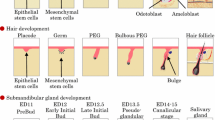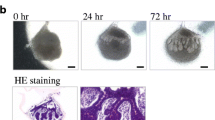Abstract
The salivary gland plays important roles in maintaining the health and homeostasis of the oral cavity by regulating functions, such as chewing, digestion, cleaning, and swallowing. Salivary gland dysfunction causes dry mouth syndrome, which includes many oral problems, such as dental caries, bacterial infection, mastication dysfunction, and swallowing dysfunction. Therefore, salivary gland regeneration is expected, and we attempted to establish a method by manual approaches. Previously, a novel three-dimensional cell manipulation technique, the “organ germ method,” to create a bioengineered organ germ enabled the regeneration of structurally correct and fully functional bioengineered organs, including the teeth, hair follicles, and secretory glands, in vivo. Here, we describe the protocol for salivary gland germ regeneration using this method and the functional analysis of the regenerated salivary gland.
Access this chapter
Tax calculation will be finalised at checkout
Purchases are for personal use only
Similar content being viewed by others
References
Avery JK (2002) Oral development and histology. Thieme, Berlin, pp 292–330
Knosp MW, Knox MS, Hoffman PM (2012) Salivary gland organogenesis. Wiley Interdiscip Rev Dev Biol 1:69–82
Tucker AS, Miletich I (2010) Salivary glands; development, adaptations, and disease. Karger, London
Jaskoll T, Melnick M (2004) Embryonic salivary gland branching morphogenesis. Madame Curie. Landes Bioscience, Austin (TX).
Edgar M, Dawes C, Mullane OD (2004) Saliva and oral health, 3rd edn. British Dental Association, London
Patel VN, Rebustini IT, Hoffman MP (2006) Salivary gland branching morphogenesis. Differentiation 74:349–364
Sakai T, Larsen M, Yamada MK (2003) Fibronectin requirement in branching morphogenesis. Nature 423:876–881A
Wei C, Larsen M, Hoffman MP, Yamada KM (2007) Self-organization and branching morphogenesis of primary salivary epithelial cells. Tissue Eng 13(4):721–735
Kagami H, Wang S, Hai B (2008) Restoring the function of salivary glands. Oral Dis 14:15–24
Nakao K, Morita R, Saji Y et al (2007) The development of a bioengineered organ germ method. Nat Methods 4:227–230
Ikeda E, Morita R, Nakao K et al (2009) Fully functional bioengineered tooth replacement as an organ replacement therapy. Proc Natl Acad Sci U S A 106:13475–13480
Oshima M, Mizuno M, Imamura A et al (2011) Functional tooth regeneration using a bioengineered tooth unit as a mature organ replacement regenerative therapy. PLoS One 6:e21531
Toyoshima K, Asakawa K, Ishibashi N et al (2012) Fully functional hair follicle regeneration through the rearrangement of stem cells and their niches. Nat Commun 3:784
Hirayama M, Ogawa M, Oshima M et al (2013) Functional lacrimal gland regeneration by transplantation of a bioengineered organ germ. Nat Commun 4:2497
Ogawa M, Oshima M, Imamura A et al (2013) Functional salivary gland regeneration by transplantation of a bioengineered organ germ. Nat Commun 4:2498
Author information
Authors and Affiliations
Corresponding author
Editor information
Editors and Affiliations
Rights and permissions
Copyright information
© 2017 Springer Science+Business Media LLC
About this protocol
Cite this protocol
Ogawa, M., Tsuji, T. (2017). Functional Salivary Gland Regeneration. In: Tsuji, T. (eds) Organ Regeneration. Methods in Molecular Biology, vol 1597. Humana Press, New York, NY. https://doi.org/10.1007/978-1-4939-6949-4_10
Download citation
DOI: https://doi.org/10.1007/978-1-4939-6949-4_10
Published:
Publisher Name: Humana Press, New York, NY
Print ISBN: 978-1-4939-6947-0
Online ISBN: 978-1-4939-6949-4
eBook Packages: Springer Protocols




